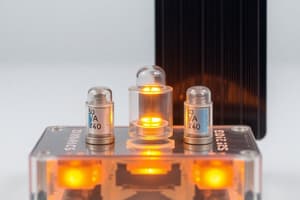Podcast
Questions and Answers
In a voltaic cell, what is the primary role of the salt bridge?
In a voltaic cell, what is the primary role of the salt bridge?
- To provide electrons for the reduction reaction.
- To physically separate the anode and cathode compartments.
- To maintain electrical neutrality in the half-cells. (correct)
- To increase the rate of the oxidation reaction.
Which component is typically the site of oxidation in a voltaic cell?
Which component is typically the site of oxidation in a voltaic cell?
- The salt bridge.
- The external circuit.
- The cathode.
- The anode. (correct)
Given the shorthand notation for a voltaic cell: $Zn(s) | Zn^{2+}(aq) || Cu^{2+}(aq) | Cu(s)$, what does the double vertical line '||' represent?
Given the shorthand notation for a voltaic cell: $Zn(s) | Zn^{2+}(aq) || Cu^{2+}(aq) | Cu(s)$, what does the double vertical line '||' represent?
- The flow of electrons in the external circuit.
- The phase boundary between the electrode and the solution.
- The direction of electron flow within the cell.
- The salt bridge connecting the two half-cells. (correct)
In a voltaic cell, what is the role of the cathode?
In a voltaic cell, what is the role of the cathode?
Using standard electrode potentials, how can the overall cell potential ($E_{cell}$) for a voltaic cell be calculated?
Using standard electrode potentials, how can the overall cell potential ($E_{cell}$) for a voltaic cell be calculated?
Which of the following shorthand notations correctly represents a voltaic cell with a zinc anode and a silver cathode?
Which of the following shorthand notations correctly represents a voltaic cell with a zinc anode and a silver cathode?
What does a negative value for the standard cell potential ($E^o_{cell}$) indicate?
What does a negative value for the standard cell potential ($E^o_{cell}$) indicate?
In the semi-ionic equation for the cathode of a voltaic cell, what is typically observed?
In the semi-ionic equation for the cathode of a voltaic cell, what is typically observed?
In a voltaic cell, if the standard reduction potential of the cathode is +0.80 V and the standard reduction potential of the anode is -0.76 V, what is the standard cell potential?
In a voltaic cell, if the standard reduction potential of the cathode is +0.80 V and the standard reduction potential of the anode is -0.76 V, what is the standard cell potential?
Which of the following factors will NOT affect the voltage of a voltaic cell?
Which of the following factors will NOT affect the voltage of a voltaic cell?
What is the purpose of using platinum as an electrode in certain voltaic cells?
What is the purpose of using platinum as an electrode in certain voltaic cells?
In a copper-zinc voltaic cell, what is the semi-ionic equation at the anode?
In a copper-zinc voltaic cell, what is the semi-ionic equation at the anode?
How does increasing the concentration of the metal ion at the cathode typically affect the cell potential of a voltaic cell?
How does increasing the concentration of the metal ion at the cathode typically affect the cell potential of a voltaic cell?
What happens to the mass of the anode in a voltaic cell as the cell operates?
What happens to the mass of the anode in a voltaic cell as the cell operates?
If a voltaic cell is set up with a standard hydrogen electrode (SHE) as the anode, what is the anode reaction?
If a voltaic cell is set up with a standard hydrogen electrode (SHE) as the anode, what is the anode reaction?
Suppose a voltaic cell is constructed with two half-cells: $Ni^{2+}(aq) + 2e^- \longrightarrow Ni(s)$ $E^o = -0.25 V$ and $Ag^+(aq) + e^- \longrightarrow Ag(s)$ $E^o = +0.80 V$. Which metal will act as the anode?
Suppose a voltaic cell is constructed with two half-cells: $Ni^{2+}(aq) + 2e^- \longrightarrow Ni(s)$ $E^o = -0.25 V$ and $Ag^+(aq) + e^- \longrightarrow Ag(s)$ $E^o = +0.80 V$. Which metal will act as the anode?
What is the primary function of the porous separator in a typical voltaic cell?
What is the primary function of the porous separator in a typical voltaic cell?
In the notation $M(s) | M^{n+}(aq) || X^{m+}(aq) | X(s)$ for a voltaic cell, what do $M$ and $X$ represent?
In the notation $M(s) | M^{n+}(aq) || X^{m+}(aq) | X(s)$ for a voltaic cell, what do $M$ and $X$ represent?
If the standard cell potential ($E^o_{cell}$) for a reaction is zero, what can be inferred about the reaction at standard conditions?
If the standard cell potential ($E^o_{cell}$) for a reaction is zero, what can be inferred about the reaction at standard conditions?
What change would likely increase electron flow in a voltaic cell?
What change would likely increase electron flow in a voltaic cell?
Flashcards
What are the components of a Voltaic cell?
What are the components of a Voltaic cell?
A voltaic cell consists of two different metals (electrodes) immersed in an electrolyte solution, separated by a salt bridge or porous membrane, where chemical reactions produce an electric current.
How does a voltaic cell work?
How does a voltaic cell work?
At the anode, oxidation occurs, releasing electrons. These electrons flow through an external circuit to the cathode, where reduction occurs. This flow of electrons constitutes an electric current.
What is the shorthand notation for voltaic cells?
What is the shorthand notation for voltaic cells?
Voltaic cells are represented using a shorthand notation that describes the cell's components and arrangement, including the anode, cathode, electrolyte solutions, and salt bridge.
How is standard electrode potential calculated?
How is standard electrode potential calculated?
Signup and view all the flashcards
What happens at the anode and cathode?
What happens at the anode and cathode?
Signup and view all the flashcards
Study Notes
- A voltaic cell consists of two different metal electrodes submerged in an electrolyte solution.
- These electrodes facilitate a chemical reaction that generates electrical energy.
Voltaic Cell Operation
- Oxidation occurs at the anode (negative electrode), where a metal loses electrons and forms positively charged ions.
- These ions dissolve into the electrolyte, releasing electrons that flow through an external circuit.
- Simultaneously, reduction takes place at the cathode (positive electrode).
- Here, metal ions from the electrolyte accept electrons from the external circuit and deposit themselves as a metal plating on the cathode.
- This continuous flow of electrons from anode to cathode through the external circuit constitutes an electric current.
- A salt bridge connecting the two electrolyte solutions maintains charge neutrality by allowing ions to flow between the half-cells, completing the circuit.
Voltaic Cell Shorthand Notation
- A shorthand notation represents a voltaic cell:
- Anode | Anode Solution || Cathode Solution | Cathode
- A single vertical line (|) represents a phase boundary between the electrode and its solution.
- Double vertical lines (||) indicate the salt bridge connecting the two half-cells.
- For example, a zinc-copper voltaic cell is represented as:
- Zn(s) | Zn2+(aq) || Cu2+(aq) | Cu(s)
Standard Electrode Potential Calculation
- The standard electrode potential (E°) measures the potential of a half-cell under standard conditions (298 K, 1 atm pressure, 1 M concentration).
- Overall cell potential (E°cell) is calculated by:
- E°cell = E°cathode - E°anode
- A positive E°cell indicates a spontaneous reaction, meaning the voltaic cell will operate as intended.
- Standard electrode potentials are relative to the standard hydrogen electrode (SHE), which is assigned a value of 0.00 V.
Semi-Ionic Equations
- Oxidation (Anode): Zn(s) → Zn2+(aq) + 2e-
- Zinc metal is oxidized, losing two electrons to form zinc ions in solution.
- Reduction (Cathode): Cu2+(aq) + 2e- → Cu(s)
- Copper ions in solution gain two electrons and are reduced to form solid copper metal.
Studying That Suits You
Use AI to generate personalized quizzes and flashcards to suit your learning preferences.




